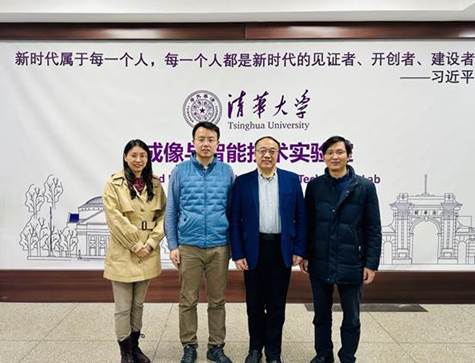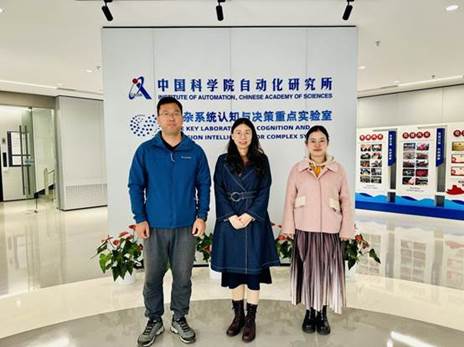.
Recently, a delegation from theSchool of Electronic and Electrical Engineering visited and studied at theInstitute of Automation, Chinese Academy of Sciences and Tsinghua University onNovember 19 and 26, 2024, respectively. I visited Academician Dai Qionghai's"Imaging and Intelligent Technology Laboratory" at TsinghuaUniversity, which was personally cared for and guided by General Secretary XiJinping. At the Institute of Automation, Chinese Academy of Sciences, wevisited the Key Laboratory of Complex System Decision making and Cognition. Thepurpose of visiting and learning is to gain cutting-edge scientific researchexperience, expand academic horizons, and explore the possibility ofcooperation between the two parties in the fields of scientific research andtechnological applications.

Associate Researcher Wan Sen fromthe Department of Automation at Tsinghua University warmly welcomed thedelegation from Shanghai University of Engineering and Technology and provideda detailed introduction to the research achievements and technologicalbreakthroughs of the Imaging and Intelligent Technology Laboratory in recentyears. The laboratory has made remarkable achievements in the field ofoptoelectronic intelligent computing, developing Fourier domain diffractionneural network (FD2NN) and reconfigurable diffraction computing processor(DPU), and successfully developing fully analog optoelectronic fusion computingchip ACCEL, large-scale universal intelligent optical computing chip"Taiji" TaiChi, and intelligent optical computing training chip"Qiankun" TsienKun. These technological innovations havesignificantly improved computing performance and energy efficiency, opening upnew directions for the sustained development of intelligent computing in thepost Moore era. In the field of high-resolution light field intelligentimaging, the Imaging and Intelligent Technology Laboratory has independentlydeveloped multi-dimensional and multi-scale light field intelligent microscopytechnology, and designed the internationally leading microscopy instrumentRUSH, breaking through the design limitations of traditional microscopyinstruments and achieving dynamic observation of the whole brain nerve in vivofor the first time. This technology provides important support for neuroscienceresearch and the development of artificial intelligence, while also opening upnew research paths for in-depth analysis of the structure and function of thenervous system. The Brain and Cognitive Science Research Center jointly establishedby the laboratory and Stanford University has further promoted internationalcooperation and academic progress in this field.
During the visit, the delegationfrom Shanghai University of Engineering and Technology also deeply appreciatedthe core concept of Academician Dai Qionghai's laboratory, which integratesscientific thinking with engineering practice, practicing original innovationin cross disciplinary fields; leading scientific frontiers in basic research,cultivating first-class talents for science and technology serving the country;leading international cooperation with original instruments, and supportingmilitary integration with independent chips. This seamless development modelfrom basic research to practical application has set an example for domesticresearch teams. After the visit, the college delegation expressed sincereappreciation for the outstanding achievements of the Imaging and IntelligentTechnology Laboratory at Tsinghua University, and expressed that the laboratoryis also a benchmark for scientific and technological innovation in China. Thecollege will take this as an opportunity to deepen cooperation and exchangewith Tsinghua University, fully absorb the successful experience of thelaboratory in the fields of optoelectronic intelligent computing andhigh-resolution light field intelligent imaging, promote the development of theartificial intelligence discipline in our university, and achieve greaterbreakthroughs in scientific research innovation and talent cultivation.
The delegation visited the KeyLaboratory of Complex System Cognition and Decision making at the Institute ofAutomation, Chinese Academy of Sciences, and exchanged ideas with the researchteam of researcher Tan Jie. The Institute of Automation of the Chinese Academyof Sciences was established in 1956, with intelligent science and technology asthe main orientation. It is the overall leader of the "ArtificialIntelligence Innovation Institute", which was first established by theChinese Academy of Sciences, the first national research institution to carryout brain like intelligence research in China, and the first leading sponsor ofthe "Artificial Intelligence Institute" in China. The Institute ofAutomation now has several national platforms, including the Laboratory ofMultimodal Artificial Intelligence Systems, the Key Laboratory of ComplexSystem Cognition and Decision making, the National Research Center for ASICDesign Engineering Technology, and several scientific research platforms inBeijing and the Chinese Academy of Sciences, and has taken the lead in buildingthe "Brain Cognitive Function Mapping and Brain like Intelligence CrossResearch Platform" of the National Integrated Science Center.

Through this exchange, the collegehas gained a deeper understanding of the development history and layout of theInstitute of Automation, Chinese Academy of Sciences. Both parties have reacheda consensus to further strengthen scientific research cooperation in thefuture, especially in major project applications in the fields of artificialintelligence and equipment manufacturing. Both parties can leverage theirrespective strengths to collaborate and promote the continuous development ofour university's intelligent science and technology discipline.